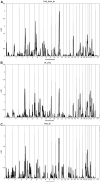Genome screen to detect linkage to common susceptibility genes for intracranial and aortic aneurysms
- PMID: 18948608
- PMCID: PMC2629798
- DOI: 10.1161/STROKEAHA.108.522631
Genome screen to detect linkage to common susceptibility genes for intracranial and aortic aneurysms
Erratum in
- Stroke. 2008 Dec;39(12):e195
Abstract
Background and purpose: Risk for both intracranial aneurysms (IAs) and aortic aneurysms (AAs) is thought to be heritable with mounting evidence for genetic predisposition. The concept of shared risk for these conditions is challenged by differences in age of diagnosis and demographic characteristics. We performed a genomewide linkage analysis in multiplex families with both IA and AA from the Familial Intracranial Aneurysm study.
Methods: Available medical records of subjects who reported IA or abdominal/thoracic AA were reviewed with adjudication as definite/probable, possible, or not a case. To identify genes contributing to the susceptibility for IA and AA, genomewide linkage analysis was performed in the 26 multiplex IA families who had members who also had thoracic or abdominal AA. Individuals (n=91) were defined as affected if they had an IA (definite/probable) or an aortic or thoracic AA (definite/probable).
Results: Maximum logarithm of odds (LOD) scores were found on chromosomes 11 (144 cM; LOD=3.0) and 6 (33 cM; LOD=2.3). In both chromosomal regions, analyses of these same 26 families considering only IA as the disease phenotype produced LOD scores of 1.8 and 1.6, respectively.
Conclusions: Our linkage analysis in these 26 families using the broadest disease phenotype, including IA, abdominal AA, and thoracic AA, supports the concept of shared genetic risk. The chromosome 11 locus appears to confirm earlier independent associations in IA and AA. The chromosome 6 finding is novel. Both warrant further investigation.
Figures
References
-
- Sandford RM, Bown MJ, London NJ, Sayers RD. The genetic basis of abdominal aortic aneurysms: a review. Eur J Vasc Endovasc Surg. 2007;33:381–390. - PubMed
-
-
Nahed BV, Bydon M, Ozturk AK, Bilguvar K, Bayrakli F, Gunel M. Genetics of intracranial aneurysms. Neurosurgery. 2007;60:213–225.; discussion 225–226.
-
-
-
Kim DH, Van Ginhoven G, Milewicz DM. Familial aggregation of both aortic and cerebral aneurysms: evidence for a common genetic basis in a subset of families. Neurosurgery. 2005;56:655–661.; discussion 655–661.
-
-
- Foroud T, Sauerbeck LR, Brown RD, Jr, Anderson C, Woo D, Kleindorfer D, Flaherty ML, Deka R, Hornung R, Meissner I, Bailey-Wilson JE, Rouleau G, Connolly ES, Lai D, Koller DL, Huston J, III, Broderick JP. FIA Study Investigators. Genome screen to detect linkage to intracranial aneurysm susceptibility genes: the Familial Intracranial Aneurysm (FIA) study. Stroke. 2008;39:1434–1440. - PMC - PubMed
Publication types
MeSH terms
Grants and funding
LinkOut - more resources
Full Text Sources
Medical
Molecular Biology Databases


